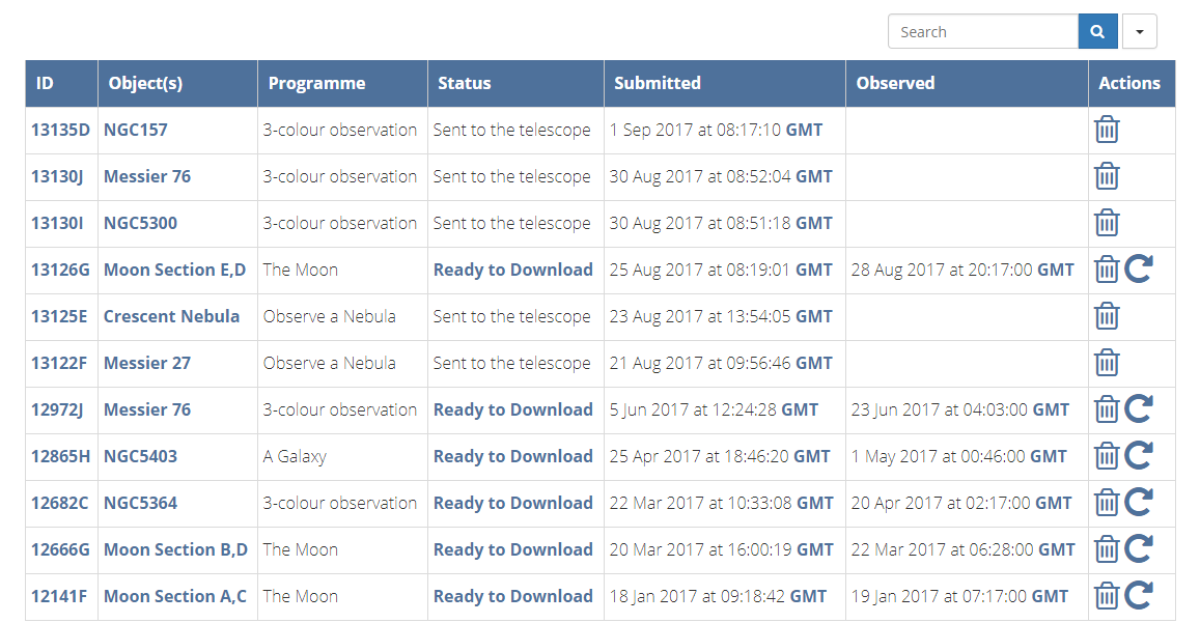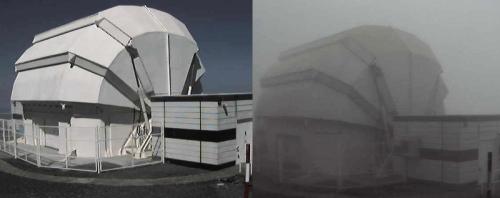Check My Observations
Once your requests have been sent to the telescope, you can simply sit back and relax - the telescope will carry them out at the best possible time.
You can keep an eye on the status of your observations using the "My Observations" tool. Here you will be given a list of all the observing programmes that you have requested with a summary of their current status.
Simply click on the Code for a particular programme to find out more details.

Once your observation has been taken and is available, you will get a message on your "My Observations" page. Click on the Code number and follow the instructions to download the image data.
You can then use The Schools' Observatory software to display, explore and analyse the data. This software, like Go Observing itself, brings the power of professional astronomy tools into the classroom in a much more "user-friendly" way.
You can find out more about what the software can do by following the help videos or simply loading in some data and playing!
In addition to the image data itself, you can also get a lot of additional information when you download your image. These include information about the weather and observing conditions. Not only are these interesting in their own right but can help you to understand any differences between observations (Was there any thin cloud? How close was the moon? etc).
How the Telescope Completes an Observation
The Liverpool Telescope (LT) uses a sophisticated computer programme called a scheduler to make sure observations are done as soon as possible and at the best time. Any observations that you have requested will be included in this.
These are the steps involved:
- Telescope Management Centre
The first stop for your request is the Telescope Management Centre in Liverpool.
ImageCreditThis work by Rept0n1x is licensed under Creative Commons Attribution Share Alike 4.0 InternationalHome of the Astrophysics Research Institue and Telescope Management Team Here a computer compares your request with any other ones that have already been submitted but are not observed yet. If any are identical they are combined (this makes it easier to get your observation done as quickly as possible).
It then works out a priority value for the request. The more requests that are combined together, the higher the priority, but it also gives a priority boost to users who have not made many requests.
As soon as this is done, your observation request is ready to be sent out to the observatory on La Palma to be put together with all the requests from everyone else who uses the telescope, including those from professional astronomers. This happens continuously, even during the night, so you can request observations whenever you want.
- Sunset
Just before sunset on La Palma, one of the LT staff in Liverpool gets online to watch the telescope systems start up. They usually do not need to do anything, but it is good to have someone to check just in case.
Image CreditThis work by Mike Tomlinson/Liverpool Telescope is licensed under Creative Commons Attribution Non Commercial Share Alike 4.0 International
CreditThis work by Mike Tomlinson/Liverpool Telescope is licensed under Creative Commons Attribution Non Commercial Share Alike 4.0 InternationalSunset at the Liverpool Telescope If the weather is OK, the dome of the telescope will open by itself, the staff member will log off, and the telescope will start observing. As it will still be quite bright, the telescope starts by taking observations that will be used to calibrate the observations taken during the rest of the night.
However, once it is dark enough, it can start trying to take observations for you and all the other astronomers who have made requests.
- During the Night
All through the night, the computers at the telescope make decisions about which observation to do next. So, whenever an observation has finished it chooses the best one to do next from the huge list of requests.
It starts by working out which could be observed. To decide if an observation is currently possible, the scheduler asks a set of questions:
- Is the object high enough above the horizon?
- Will it stay high enough all the way through observation (this depends on the exposure time)?
- Will it be possible to finish the observation before the end of the night?
- Is the sky dark enough for the needs of this particular observation?
- Is the "seeing" good enough for the observation?
- If the observation needs the very best conditions, is it a night with no cloud at all?
- If it has to be done at a special time (say at a particular point in an orbit, or when a variable star is very bright), is the time right?
Only if the answer to all of these is "yes" will it pass the request on to the next stage. This narrows down the big list to a smaller one of all the observations that could possibly be done now.
These are then ranked using a special piece of computer code called an algorithm. The observation with the highest rank is then observed and the process starts again.
The rank given to each possible observation depends on:
- Slew time: This is a measure of how far the across the sky the telescope will need to move from its current position. The less it has to move the better, as this is more efficient.
- Height above the horizon: If the object is going to be further above the horizon later in the night, it might be better to wait, so the rank number is lowered a bit until then. It does not compare it to other objects in other observations though.
- Priority: Higher priority observations are given a boost to their ranking.
- Completion: Big science projects that need lots of observations over a number of nights, or even months, are also given a bit of a boost as otherwise completing them might be difficult.
The overall rank number for each possible observation at that particular moment is then compared and the one with the highest rank is observed.
Because it starts again with the full list every time rather than planning the whole night in one go, the telescope can make observations from requests that have only just been made. This is very useful for trying to learn more about things change very quickly or unpredictably, such as exploding stars like supernovae or gamma-ray bursts.
It also means that whenever you make your request - even in the middle of the night - the telescope will start trying to observe it straight away.
- Sunrise
As the Sun rises, the dome closes automatically. All the data that was taken during the night is then carefully calibrated by another computer programme using the special observations taken during the night.
All observations sent from The Schools' Observatory are checked by a member of the team. Sometimes you might have been unlucky and your observation might have been taken through a small unexpected cloud, or there might have been a technical problem. This is quite rare, but if it happens we will simply send your request back to the telescope to try again.
Finally, the data files for your observation are copied over to The Schools' Observatory website and are ready for you to download and explore.
Incomplete Observations
- Why might my observation be delayed or not completed at all?
Sometimes you might need to wait a while for your observation, or it might not be possible for the telescope to complete it in time for you.
Image CreditThis work by Liverpool Telescope/The Schools' Observatory is licensed under All rights reserved
CreditThis work by Liverpool Telescope/The Schools' Observatory is licensed under All rights reservedTwo different days at the Liverpool Telescope Because the weather is so important, patience is very important in observational astronomy, but there are a few things that might help you to understand why you might not be lucky with your observations:
- Seasons: Even when you observe quite close to the equator like on La Palma, the nights are longer in winter than summer, so that might seem like a better time to observe. However, the winter weather is often worse, so it is still down to luck.
- Across the Sky: As the Earth spins around each day, and orbits around the Sun each year, the part of the sky that can been seen changes. To help work out if something is visible at a particular time, we use coordinates. (You can learn more about coordinates in Plan an Observation and Sky Coordinates).
- Sky Brightness: While some things in the night sky are quite bright like the Moon or some stars, many of the things we want to observe are quite faint. The fainter something is, the harder it is to observe, especially if the sky is not really dark. Fortunately on La Palma we do not need to worry about light pollution, but some other things, like twilight or the Moon, can make the sky a bit too bright to observe the faintest objects. (You can learn more about sky brightness in Plan an Observation.)
- Seeing: "Seeing" is what astronomers call the "blurring" of astronomical pictures by the atmosphere. The amount of blurring changes and observations that need the sharpest possible images can only be done at certain times. The telescope measures the quality of the seeing all the time, so it will take observations that need to be good only when conditions are right. This means that requests which ask for the best conditions have more competition in the "ranking", whereas if the poorer quality is OK, then it is easier for the telescope to fit the observation in.
- Long vs Short: Observations that take a long time to carry out are harder for the telescope to fit in than those that are quick. So observations with long exposure times or several observations taken together (like those for 3-Colour images might take longer to get observed.
- Priority: Ideally, all requests for observations would be taken, but there are so many things that nobody has any control over (from bad weather to unexpected but exciting things like exploding stars) that it is impossible to guarantee that. To help the telescope decide which are the most important to finish, all requests are given a "priority". For research astronomers, the priority is decided by a committee who think about what all the astronomers who are using the telescope want to do, and which are the most exciting or important. For observations sent through The Schools' Observatory, we use the priority to both boost observations that a lot of people want to get done, and give people who have not used the telescope much a bigger chance of getting their first observations done quickly. However, this is only used together with all the other factors - lower priority observations might still be done first if all of the other conditions are better for them.
- What can I do if my observation was not completed?
The simplest thing to do is to try again! If you are sure that the observation is exactly what you want, just go to your list of observations and click on the resubmit button ( ).
However, if your observation was hard for the telescope to take the first time, it could be just as hard now, so you might want to try something a bit different. In which case, go back to Go Observing and see what you might change.
For example, you might find a similar object that is easier for the telescope to fit in (check the coloured "Observability" bars). Or you may want to get a single-colour observation rather than a 3-colour one.
